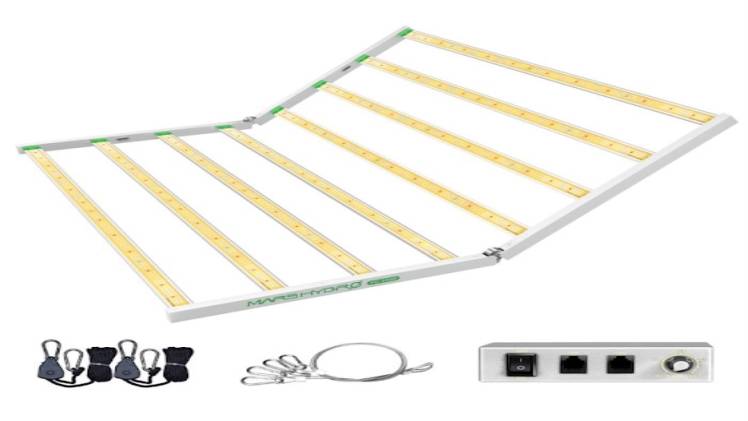Key factors to consider before buying LED grow light

Growers who want the benefits of high-intensity discharge (HID) lighting but don’t want to deal with the trouble and cost of using those bulbs can use LED grow lights instead. LED grow lights, on the other hand, come in many different shapes and sizes and have different features that make them good for different types of growing. Here are some key things to keep in mind when buying an LED grow light:
Spectrum
To make sure you’re giving your plants the best conditions for growth, you need to know the spectrum of light that your grow light gives off.
There are many different spectrums of LED grow lights, but most of them are full spectrum, which means they give off light in all of the visible colors (think ROY G BIV). Full-spectrum lighting is great for healthy photosynthesis in plants because it mimics natural sunlight.
This makes it easy for your plants to grow and thrive. LEDs also have a wider range of wavelengths that can be changed as needed. For example, red and infrared wavelengths can be used during the flowering stage without affecting the growth of the plant’s leaves.
Coverage Area
The number of plants that can grow under the light is the coverage area. You need to think about this if you want to grow more than one plant. The coverage area is usually given in square feet , so it’s important to know how many plants can fit in an area that size.
If you have a small area, then it would be best if there was at least 1 ft² per plant; however, if you have a larger space then having 2 or 3 ft² per plant is not a problem.
When figuring out the coverage area, think about how much space the grower and any tools they may need to use while working with the plants will need. You also need a lot of space to move around in your grow room without running into anything.
If you do, you could hurt yourself or your lights. Before you decide what kind of LED light system will work best for you based on the size of your grow room, you should think about all of these things.
Heat Management
LED grow lights work better than HID and fluorescent grow lights, but they do make heat. This can be a problem if you live in a place where it’s often hotter than 80 degrees Fahrenheit in the summer. Heat shortens the life of LED grow lights because over time it causes more power loss and circuit failures.
If you live in a place where summer temperatures often go above 80 degrees Fahrenheit, you should think about using something other than an LED grow light, like a metal halide or high pressure sodium lighting system, even though these are not as effective.
Power Draw
One thing to think about is how much power your grow light needs. The higher the wattage, the more heat it will produce, which means it will need more air flow.
If you want to run a lot of lights at once, you should buy something with a higher wattage so that it costs less per hour to run them.
Warranty and Support
When you want to buy an LED grow light, you should pay attention to the warranty and customer service. The warranty should last at least three years, and the company should have a phone number and an email address that can be reached at any time.
Some companies may also offer lifetime warranties on their products, but these aren’t as common, so it’s best to stick with the 3-year warranty when you can.
If you have any questions while your LED grow light is being set up or used over time, make sure someone from the company is available to answer them day or night.
PPF Value
Photosynthesis Photon Flux (PPF) is a way to measure how bright the light is. The higher the PPF value, the more light will come from that source to your plants.
Micromoles per second per square meter (mol/s/m2) are used to measure PPF. PPF is usually measured in mol/s, which tells us how many photons are hitting a plant at any given time (micromoles per second).
Lifespan
The average life of an LED grow light is more than 50,000 hours, which is a lot longer than the average life of HPS/MH lights. This is because LEDs last much longer than HPS or MH lamps. Because they make less heat, LEDs are easier to take care of and can last longer.
Efficiency
The amount of useful light that an LED grow light gives off per watt is a measure of how efficient it is. The more efficient your light, the better it will work. For PPF, efficiency is measured in lumens per watt or micromoles per second.
LEDs have different efficiency ratings based on how they are made and what they are used for. Most LEDs used for indoor growing fall between 50 and 100 LPW. Some special LEDs, such as quantum dots, can be as bright as 200 LPW!
PAR Rating
PAR stands for Photosynthetic Active Radiation and is a measure of light in the 400-700nm wavelengths. This is the range of light that plants use for photosynthesis, so it should be the first thing you think about when buying a grow light.
The PAR rating shows how much total Photosynthetic Active Radiation (PAR) an LED bar gives off compared to a HID lamp. The more useful and effective it is for growing plants, the higher the PAR rating.
Grow Light Size
Before you buy a light, you should think about how big your grow space is. The less powerful your light will need to be, the smaller the room is. If you have a small closet or grow tent, a 250-watt LED may be enough. This is the smallest size we recommend.
If you want to start an indoor garden in a large room or basement, you should buy a stronger light that covers a larger area. A 600-watt LED will cover larger areas completely, but it costs more and uses more electricity than smaller models.
Conclusion
When you’re thinking about getting LED grow lights for your garden, you should think about these key things. This will help you remember what’s important when you’re looking for a grow light and make sure it fits your needs.




